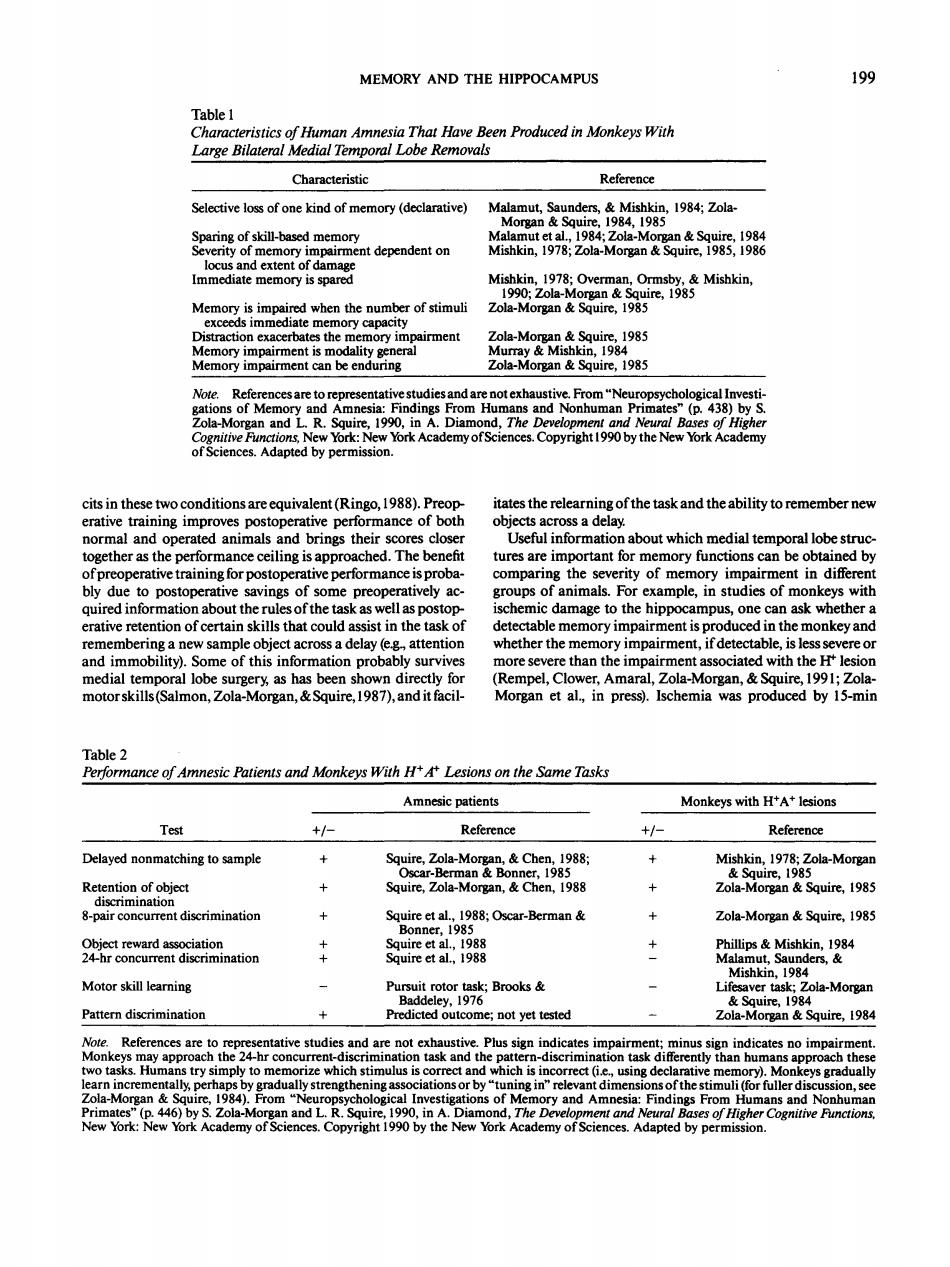正在加载图片...

MEMORY AND THE HIPPOCAMPUS 199 Table 1 That Have Been Produced in Monkeys With Reference Selective of memory(decarative) skil-basme n:278eS9t18 diate memory is spared zola-M d L ad Am Diam of Sciences Adapted by permission. cisntheemocodiosaeaaaiCRnonl193817T86 etheen of the task and the abilitytoemere medial temporal together as the performance ceiling is approached.The tures are important for n mory func ions can be obt ed by ups of animais.For xamp in studies of monkeys with 、skills that oud assist in t s a dela ether the n emory imp ess sever medial temn al lohe el.Clo Amaral.Zola-Morgan.&Squire.199:Zola motorskills(Salmon,Zola-Morgan,&Squire,197),andit facil Morgan et al,in press).Ischemia was produced by 15-mi Table 2 Performance of Amnesic Patients and Monkeys With HA Lesions on the Same Tasks Amnesic patients Monkeys with H+A*lesions Te对 + Reference Delayed nonmatching to sample Mishkin,197:Zola-Morgan g.garconcurTentdiscrimination Squire et al.,1988:Oscar-Berman + Zola-Morgan&Squire,1985 omcmtmo Motor skill learning la-Morgar 8nrmtisgnindicatsnoimpair of the s for fullerd ons ofMEMORY AND THE HIPPOCAMPUS 199 Table 1 Characteristics of Human Amnesia That Have Been Produced in Monkeys With Large Bilateral Medial Temporal Lobe Removals Characteristic Reference Selective loss of one kind of memory (declarative) Sparing of skill-based memory Severity of memory impairment dependent on locus and extent of damage Immediate memory is spared Memory is impaired when the number of stimuli exceeds immediate memory capacity Distraction exacerbates the memory impairment Memory impairment is modality general Memory impairment can be enduring Malamut, Saunders, & Mishkin, 1984; ZolaMorgan & Squire, 1984, 1985 Malamut etal, 1984; Zola-Morgan & Squire, 1984 Mishkin, 1978; Zola-Morgan & Squire, 1985,1986 Mishkin, 1978; Overman, Ormsby, & Mishkin, 1990; Zola-Morgan & Squire, 1985 Zola-Morgan & Squire, 1985 Zola-Morgan & Squire, 1985 Murray & Mishkin, 1984 Zola-Morgan & Squire, 1985 Note. References are to representative studies and are not exhaustive. From "Neuropsychological Investigations of Memory and Amnesia: Findings From Humans and Nonhuman Primates" (p. 438) by S. Zola-Morgan and L. R. Squire, 1990, in A. Diamond, The Development and Neural Bases of Higher Cognitive Functions, New York: New York Academy of Sciences. Copyright 1990 by the New \fork Academy of Sciences. Adapted by permission. cits in these two conditions are equivalent (Ringo, 1988). Preoperative training improves postoperative performance of both normal and operated animals and brings their scores closer together as the performance ceiling is approached. The benefit of preoperative training for postoperative performance is probably due to postoperative savings of some preoperatively acquired information about the rules of the task as well as postoperative retention of certain skills that could assist in the task of remembering a new sample object across a delay (e.g., attention and immobility). Some of this information probably survives medial temporal lobe surgery, as has been shown directly for motor skills (Salmon, Zola-Morgan, & Squire, 1987), and it facilitates the relearning of the task and the ability to remember new objects across a delay. Useful information about which medial temporal lobe structures are important for memory functions can be obtained by comparing the severity of memory impairment in different groups of animals. For example, in studies of monkeys with ischemic damage to the hippocampus, one can ask whether a detectable memory impairment is produced in the monkey and whether the memory impairment, if detectable, is less severe or more severe than the impairment associated with the H4 " lesion (Rempel, Glower, Amaral, Zola-Morgan, & Squire, 1991; ZolaMorgan et al., in press). Ischemia was produced by 15-min Table 2 Performance of Amnesic Patients and Monkeys With H+A* Lesions on the Same Tasks Amnesic patients Test Reference Monkeys with H+A + lesions Reference Delayed nonmatching to sample + Retention of object + discrimination 8-pair concurrent discrimination + Object reward association + 24-hr concurrent discrimination + Motor skill learning - Pattern discrimination + Squire, Zola-Morgan, & Chen, 1988; + Oscar-Herman & Bonner, 1985 Squire, Zola-Morgan, & Chen, 1988 + Squire et al., 1988; Oscar-Berman & + Bonner, 1985 Squire et al., 1988 + Squire etal., 1988 Pursuit rotor task; Brooks & - Baddeley, 1976 Predicted outcome; not yet tested - Mishkin, 1978; Zola-Morgan & Squire, 1985 Zola-Morgan & Squire, 1985 Zola-Morgan & Squire, 1985 Phillips & Mishkin, 1984 Malamut, Saunders, & Mishkin, 1984 Lifesaver task; Zola-Morgan & Squire, 1984 Zola-Morgan & Squire, 1984 Note. References are to representative studies and are not exhaustive. Plus sign indicates impairment; minus sign indicates no impairment. Monkeys may approach the 24-hr concurrent-discrimination task and the pattern-discrimination task differently than humans approach these two tasks. Humans try simply to memorize which stimulus is correct and which is incorrect (i.e., using declarative memory). Monkeys gradually learn incrementally, perhaps by gradually strengthening associations or by "tuning in" relevant dimensions of the stimuli (for fuller discussion, see Zola-Morgan & Squire, 1984). From "Neuropsychological Investigations of Memory and Amnesia: Findings From Humans and Nonhuman Primates" (p. 446) by S. Zola-Morgan and L. R. Squire, 1990, in A. Diamond, The Development and Neural Bases of Higher Cognitive Functions, New York: New York Academy of Sciences. Copyright 1990 by the New \fork Academy of Sciences. Adapted by permission